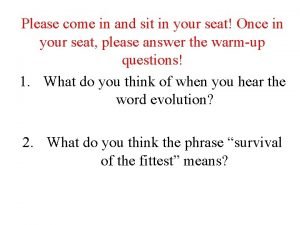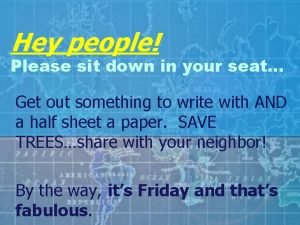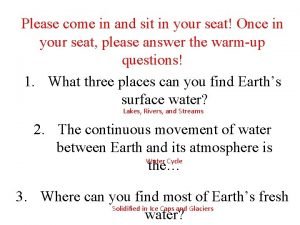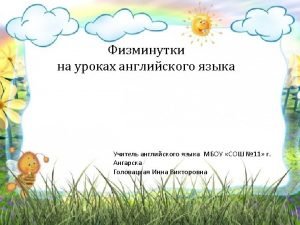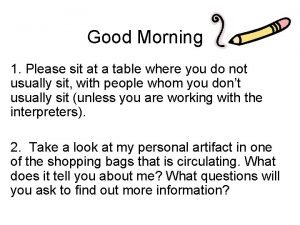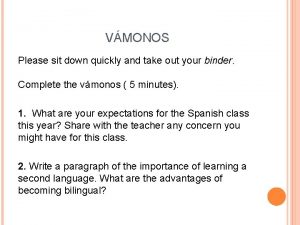Classification Unit 3 Classification Activity Please sit down



























- Slides: 27

Classification Unit 3

Classification Activity • Please sit down if you: • • Are taller than 5’ 9” Have blonde Hair Have brown Eyes Are left-Handed

Why Classify? • To study the diversity of life, biologists use a classification system to name organisms and group them in a logical manner. • Taxonomy: science of classification • By using a scientific name, scientists can be sure everyone is discussing the same organism. mountain lion ? puma? cougar ? panther? cientific name = Felis concolor

Assigning Scientific Names • Aristotle attempted to classify organisms based on where they lived - land, water or air. • With the invention of the microscope, classifying the diversity of life became difficult. • A major step was taken by Carolus Linnaeus who developed binomial nomenclature (two-name naming system. ) • In binomial nomenclature, each species is assigned a two-part scientific name, which is always written in italics. First name is capitalized and second is lowercase.

Binomial Nomenclature Ursus arctos Genus Species

Dichotomous Key • Tool to help user identify living and non-living things. • Dichotomous comes from two Greek words that together mean, “divided into two parts”. • In each step of the key, only two choices are given; a direction is given or the organisms scientific name.

Dichotomous Key

Dichotomous Key Activity

Class Activity!

Make your own Dichotomous Key

Warm-Up!

Linnaeus’s System of Classification • Linnaeus's hierarchical system of classification includes eight levels: • • Domain Kingdom hylum lass rder amily enus pecies • Each level is called a taxon (pl. taxa). • Species: organisms that look alike and inter-breed under natural conditions.

Trick! • • Definitely Keep Pond Clean Or Froggy Gets Sick Domain Kingdom Phylum Class Order Family Genus Species

Read and Respond

Warm-Up! • What are the eight levels of classification? • What are the 3 domains? • What are the 6 kingdoms?

Kingdoms and Domains • Linnaeus's two kingdoms, Animalia and Plantae did not adequately represent the diversity of life. • Microorganisms became kingdom Protista. • Mushrooms, yeasts and molds were placed in Fungi. • Later, bacteria were named kingdom Monera. • More recently, kingdom Monera was subdivided into two groups: Eubacteria and Archaebacteria.

Domains • Three domains • Eukarya (Protists, Fungi, Plantae, Animalia) • Bacteria (Eubacteria) • Archaea (Archaebacteria)

Domain Bacteria

Domain Bacteria • Extremely Diverse • Some photosynthetic • Some pathogenic (causing disease) • Some need oxygen to live, others are killed by oxygen Streptococcus Escherichia coli

Domain Archaea

Domain Archaea • Live in extreme environments • Volcanic hot springs • Brine pools • Bottom of the ocean • Many can only survive in the absence of oxygen Halophiles Methanogens

Domain Eukarya

Eukarya-Protista • Great variety • Three basic groups • Animal-like • Plant-like • Fungi-like Amoeba Paramecium

Eukarya-Fungi • Feed on dead or decaying matter • Secrete digestive enzymes, then absorb small molecules • Cell walls made of chitin

Eukarya-Plantae • Non motile-cannot move from place to place • Cell walls made of cellulose

Eukarya-Animalia • Heterotrophic – must eat others to survive • No cell walls

Time to Practice! • Pg 461: # 3 -5 • Pg 463: Classify the leaves using dichotomous key • Pg 465: #1 -5, 8 -10
 Please come in and have a seat
Please come in and have a seat Hey hey people
Hey hey people Please come in and take a seat
Please come in and take a seat Please sit down
Please sit down Hand on hip
Hand on hip Sit means sit nashville
Sit means sit nashville Will't please you sit and look at her
Will't please you sit and look at her Please sit at the table
Please sit at the table Visiting tutor
Visiting tutor Please sit back and relax
Please sit back and relax Sit down quickly
Sit down quickly Stand up sit down game
Stand up sit down game Sit down quietly
Sit down quietly Sit down quietly
Sit down quietly Sit down and take notes
Sit down and take notes Reported questions
Reported questions Unit 1 hello everybody
Unit 1 hello everybody Come in come in and sit down
Come in come in and sit down Come in come in and sit down
Come in come in and sit down Will you please be quiet please themes
Will you please be quiet please themes Do you mind turn off the music
Do you mind turn off the music Our beloved father please come down and meet us
Our beloved father please come down and meet us Daniel aleshire
Daniel aleshire Please jot down
Please jot down Unit 10, unit 10 review tests, unit 10 general test
Unit 10, unit 10 review tests, unit 10 general test King jesus you're the name
King jesus you're the name There's a place where mercy reigns
There's a place where mercy reigns Pushing down on me pushing down on you
Pushing down on me pushing down on you
